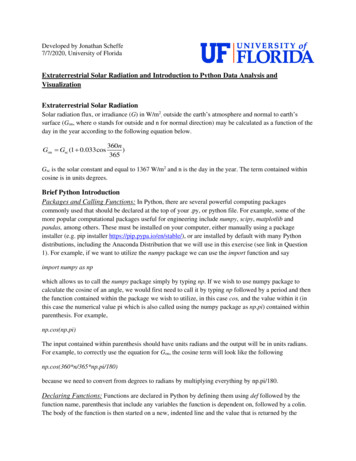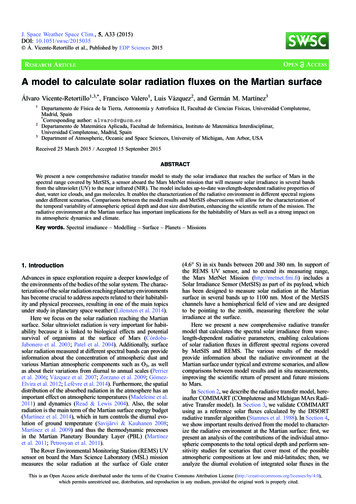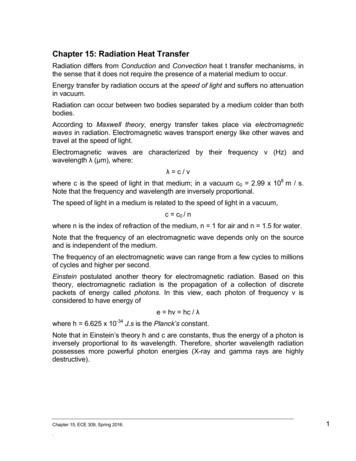
Transcription
Developed by Jonathan Scheffe7/7/2020, University of FloridaExtraterrestrial Solar Radiation and Introduction to Python Data Analysis andVisualizationExtraterrestrial Solar RadiationSolar radiation flux, or irradiance (G) in W/m2, outside the earth’s atmosphere and normal to earth’ssurface (Gon, where o stands for outside and n for normal direction) may be calculated as a function of theday in the year according to the following equation below.Gon Gsc (1 0.033cos360n)365Gsc is the solar constant and equal to 1367 W/m2 and n is the day in the year. The term contained withincosine is in units degrees.Brief Python IntroductionPackages and Calling Functions: In Python, there are several powerful computing packagescommonly used that should be declared at the top of your .py, or python file. For example, some of themore popular computational packages useful for engineering include numpy, scipy, matplotlib andpandas, among others. These must be installed on your computer, either manually using a packageinstaller (e.g. pip installer https://pip.pypa.io/en/stable/), or are installed by default with many Pythondistributions, including the Anaconda Distribution that we will use in this exercise (see link in Question1). For example, if we want to utilize the numpy package we can use the import function and sayimport numpy as npwhich allows us to call the numpy package simply by typing np. If we wish to use numpy package tocalculate the cosine of an angle, we would first need to call it by typing np followed by a period and thenthe function contained within the package we wish to utilize, in this case cos, and the value within it (inthis case the numerical value pi which is also called using the numpy package as np.pi) contained withinparenthesis. For example,np.cos(np.pi)The input contained within parenthesis should have units radians and the output will be in units radians.For example, to correctly use the equation for Gon, the cosine term will look like the followingnp.cos(360*n/365*np.pi/180)because we need to convert from degrees to radians by multiplying everything by np.pi/180.Declaring Functions: Functions are declared in Python by defining them using def followed by thefunction name, parenthesis that include any variables the function is dependent on, followed by a colin.The body of the function is then started on a new, indented line and the value that is returned by the
function must be declared at the end using return. For example, if we wish to define a function y thatdepends on x and is a linear line with slope m and intercept y we would writedef y(x):return m*x band to evaluate the function we would simply call it by typingy(x)ExerciseComplete the following questions that deal with determining Gon using the above equation and a moreaccurate form of the equation (not shown, Gon accurate function), as a way to get comfortablecomputing in Python using some basic techniques, learning to call and declare functions, plotting datausing the package matplotlib, and using two different methods to evaluate python code, namely atraditional editor named Spyder and a web based notebook style editor called Jupyter.1) Download Python from https://www.anaconda.com/ (“Anaconda Distribution”). Thisincludes many useful packages but most commonly we will use Spyder and Jupyter, twodifferent ways to evaluate Python code.2) Open and run “Extraterrestrial Radiation Calculator.py” using Spyder. This can bedownloaded as a pdf file from the website energy-educational-resources/, then copied and pasted into the Spydereditor and saved to your computer as a .py file. Alternatively, it can be copied and pastedfrom the appendix of this document and saved to your computer as a .py file. Afterrunning, you should see a plot with two curves.
3) Replot the data using the same code but change the plotted lines from red ‘r’ and blue ‘b’in the plt.plot lines of code, to other colors of your choice. Here are examples and moredocumentation- https://matplotlib.org/2.0.2/api/colors roductory/pyplot.html4) We have plotted data every day using the function np.arrange with the linedays np.arange(1,365,1). This creates an array from 1 to 365 with a spacing of 1.However, lets imagine we want to see individual data points plotted – it would bedifficult to distinguish between them with so many. Therefore, lets plot a point every 10days by changing the spacing from 1 to 10. Show the results using blue circles for theblue curve by inserting ‘bo’ in place of ‘b’.
5) Use Python Jupyter Notebook to the plot the extraterrestrial solar radiation (Gon) betweenMarch 1st and July 1st. Copy and paste lines from the prior “Extraterrestrial RadiationCalculator.py.py file”. You can group common lines of code in their own cells that can beevaluated independently from the remaining cells. At the end of that file are a few linesof code that you can use to determine the day in the year knowing a date. Adding a # signat the beginning of each line is used to comment and is not evaluated. Copy and pastethese lines into a new Jupyter cell to determine what days the required dates correspondto.For example, to determine the day in the year on March 1st see below. Thus the day onMarch 1st is 61 and July 1st is 183.Now we will plot between only these days by changing days to equaldays np.arange(61,183,1). Below is a screenshot of the cells and output.
Appendix# Jonathan Scheffe - Extraterrestrial Solar Radiation Calculator 20200103#from datetime import datetime,date,time,timedeltaimport datetime# import timeimport math#from geopy.geocoders import Nominatimimport matplotlib.pyplot as pltimport numpy as npGsc 1367 #W m-2def Gon(n):return Gsc*(1 ays np.arange(1,365,1)#print(days)#print(Gon(days))def B(n):return (n-1)*360/365*np.pi/180def Gon accurate(n):returnGsc*(1.000110 0.034221*np.cos(B(n)) .001280*np.sin(B(n)) .000719*np.cos(2*B(n)) .000077*np.sin(2*B(n)))plt.plot(days, Gon(days),'r')plt.plot(days, Gon accurate(days),'b')plt.xlabel('Day # in Year')plt.ylabel('Gon, W m-2')plt.show()#needed to display plot#To get day in a yeartoday datetime.datetime.now()day of year (datetime.datetime(today.year, 8, 6) - datetime.datetime(today.year, 1, 1)).days 1#Enter month (1 through 12) and day in month on LHS#print(day of year)
Extraterrestrial Solar Radiation and Introduction to Python Data Analysis and Visualization Extraterrestrial Solar Radiation Solar radiation flux, or irradiance (G) in W/m2, outside the earth’s atmosphere and normal to earth’s surface (G on, where o stands for outside and n for











